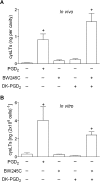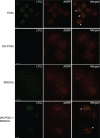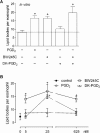Co-operative signalling through DP(1) and DP(2) prostanoid receptors is required to enhance leukotriene C(4) synthesis induced by prostaglandin D(2) in eosinophils
- PMID: 20973774
- PMCID: PMC3081113
- DOI: 10.1111/j.1476-5381.2010.01086.x
Co-operative signalling through DP(1) and DP(2) prostanoid receptors is required to enhance leukotriene C(4) synthesis induced by prostaglandin D(2) in eosinophils
Abstract
Background and purpose: Prostaglandin (PG) D(2) has emerged as a key mediator of allergic inflammatory pathologies and, particularly, PGD(2) induces leukotriene (LT) C(4) secretion from eosinophils. Here, we have characterized how PGD(2) signals to induce LTC(4) synthesis in eosinophils.
Experimental approach: Antagonists and agonists of DP(1) and DP(2) prostanoid receptors were used in a model of PGD(2) -induced eosinophilic inflammation in vivo and with PGD(2) -stimulated human eosinophils in vitro, to identify PGD(2) receptor(s) mediating LTC(4) secretion. The signalling pathways involved were also investigated.
Key results: In vivo and in vitro assays with receptor antagonists showed that PGD(2) -triggered cysteinyl-LT (cysLT) secretion depends on the activation of both DP(1) and DP(2) receptors. DP(1) and DP(2) receptor agonists elicited cysLTs production only after simultaneous activation of both receptors. In eosinophils, LTC(4) synthesis, but not LTC(4) transport/export, was activated by PGD(2) receptor stimulation, and lipid bodies (lipid droplets) were the intracellular compartments of DP(1) /DP(2) receptor-driven LTC(4) synthesis. Although not sufficient to trigger LTC(4) synthesis by itself, DP(1) receptor activation, signalling through protein kinase A, did activate the biogenesis of eosinophil lipid bodies, a process crucial for PGD(2) -induced LTC(4) synthesis. Similarly, concurrent DP(2) receptor activation used Pertussis toxin-sensitive and calcium-dependent signalling pathways to achieve effective PGD(2) -induced LTC(4) synthesis.
Conclusions and implications: Based on pivotal roles of cysLTs in allergic inflammatory pathogenesis and the collaborative interaction between PGD(2) receptors described here, our data suggest that both DP(1) and DP(2) receptor antagonists might be attractive candidates for anti-allergic therapies.
© 2011 The Authors. British Journal of Pharmacology © 2011 The British Pharmacological Society.
Figures








Comment in
-
R2D(2) for C(4)Eo: an 'alliance' of PGD(2) receptors is required for LTC(4) production by human eosinophils.Br J Pharmacol. 2011 Apr;162(8):1671-3. doi: 10.1111/j.1476-5381.2011.01236.x. Br J Pharmacol. 2011. PMID: 21426314 Free PMC article.
Similar articles
-
R2D(2) for C(4)Eo: an 'alliance' of PGD(2) receptors is required for LTC(4) production by human eosinophils.Br J Pharmacol. 2011 Apr;162(8):1671-3. doi: 10.1111/j.1476-5381.2011.01236.x. Br J Pharmacol. 2011. PMID: 21426314 Free PMC article.
-
Leptin Elicits LTC4 Synthesis by Eosinophils Mediated by Sequential Two-Step Autocrine Activation of CCR3 and PGD2 Receptors.Front Immunol. 2018 Sep 20;9:2139. doi: 10.3389/fimmu.2018.02139. eCollection 2018. Front Immunol. 2018. PMID: 30298073 Free PMC article.
-
Pharmacologic profile of OC000459, a potent, selective, and orally active D prostanoid receptor 2 antagonist that inhibits mast cell-dependent activation of T helper 2 lymphocytes and eosinophils.J Pharmacol Exp Ther. 2012 Feb;340(2):473-82. doi: 10.1124/jpet.111.187203. Epub 2011 Nov 21. J Pharmacol Exp Ther. 2012. PMID: 22106101
-
CRTH2 and D-type prostanoid receptor antagonists as novel therapeutic agents for inflammatory diseases.Pharmacology. 2010;85(6):372-82. doi: 10.1159/000313836. Epub 2010 Jun 16. Pharmacology. 2010. PMID: 20559016 Review.
-
Eosinophils and cysteinyl leukotrienes.Prostaglandins Leukot Essent Fatty Acids. 2003 Aug-Sep;69(2-3):135-43. doi: 10.1016/s0952-3278(03)00074-7. Prostaglandins Leukot Essent Fatty Acids. 2003. PMID: 12895596 Review.
Cited by
-
Schistosomal Lipids Activate Human Eosinophils via Toll-Like Receptor 2 and PGD2 Receptors: 15-LO Role in Cytokine Secretion.Front Immunol. 2019 Jan 25;9:3161. doi: 10.3389/fimmu.2018.03161. eCollection 2018. Front Immunol. 2019. PMID: 30740113 Free PMC article.
-
Eosinophils as a novel cell source of prostaglandin D2: autocrine role in allergic inflammation.J Immunol. 2011 Dec 15;187(12):6518-26. doi: 10.4049/jimmunol.1101806. Epub 2011 Nov 18. J Immunol. 2011. PMID: 22102725 Free PMC article.
-
Emerging Role of Phospholipase-Derived Cleavage Products in Regulating Eosinophil Activity: Focus on Lysophospholipids, Polyunsaturated Fatty Acids and Eicosanoids.Int J Mol Sci. 2021 Apr 21;22(9):4356. doi: 10.3390/ijms22094356. Int J Mol Sci. 2021. PMID: 33919453 Free PMC article. Review.
-
Eicosanoids in metabolic syndrome.Adv Pharmacol. 2013;66:157-266. doi: 10.1016/B978-0-12-404717-4.00005-6. Adv Pharmacol. 2013. PMID: 23433458 Free PMC article. Review.
-
DP1 receptor signaling prevents the onset of intrinsic apoptosis in eosinophils and functions as a transcriptional modulator.J Leukoc Biol. 2018 Jul;104(1):159-171. doi: 10.1002/JLB.3MA1017-404R. Epub 2018 Apr 1. J Leukoc Biol. 2018. PMID: 29607536 Free PMC article.
References
-
- Bandeira-Melo C, Weller PF. Eosinophils and cysteinyl leukotrienes. Prostaglandins Leukot Essent Fatty Acids. 2003;69:135–143. - PubMed
-
- Bandeira-Melo C, Phoofolo M, Weller PF. Extranuclear lipid bodies, elicited by CCR3-mediated signaling pathways, are the sites of chemokine-enhanced leukotriene C4 production in eosinophils and basophils. J Biol Chem. 2001;276:22779–22787. - PubMed
-
- Bandeira-Melo C, Bozza PT, Weller PF. The cellular biology of eosinophil eicosanoid formation and function. J Allergy Clin Immunol. 2002a;109:393–400. - PubMed
Publication types
MeSH terms
Substances
LinkOut - more resources
Full Text Sources
Other Literature Sources
Miscellaneous

